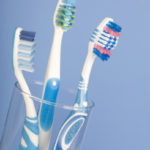
The regular removal of dental plaque is important for the prevention and control of oral disease. For a majority of people this means the twice daily use of a toothbrush. Various designs of brush head design are available and these can influence the effectiveness of plaque removal. The triple-headed brush is one unconventional design and there are claims that it makes it easier to brush properly.
The aim of this review was to assess the literature concerning the effectiveness of the triple-headed manual toothbrush compared to the single-headed manual toothbrush with respect to plaque removal.
Methods
Searches were conducted in the Medline, and Cochrane Central Register of Controlled Trials (CENTRAL) databases with no language restrictions. This was supplemented by handsearching the Journal of Disability and Oral Health.
Randomised controlled trials (RCT) or controlled clinical trials (CCT) studies comparing effect on plaque removal of toothbrushing with a triple-headed and a single-headed manual toothbrush in patients without fixed orthodontic appliances were considered. Brushing could be performed by patient or a non-dental professional care giver. Two reviewers independently abstracted data and assessed study quality.
Results
- 15 papers describing 18 comparisons were included.
- 6 studies were considered to be at low risk of bias, 8 at moderate risk and 1 at high risk.
- 5 comparisons involved patients with varying degrees of physical and/or intellectual disabilities,8 involved health children and 5 health adults.
- Brushing regimes varied widely from no instruction to extensive training.
- A variety of plaque indices and their modifications was used.
- A majority of the comparisons (14) involving self-performed brushing showed no difference between triple-headed and single-headed toothbrushes, with a few favouring the triple-headed.
- In comparisons involving caregiver performed the brushing three of the four showed that the triple-headed toothbrush performed significantly better on the reduction in plaque scores.
Conclusions
The authors concluded: –
From this review emerges the recommendation that the use of a triple-headed manual toothbrush instead of a single-headed manual toothbrush might be favourable with respect to plaque removal in case a care-dependent individual is brushed by a caregiver
Comments
This well conducted review identifies a number of relevant studies on the use of triple headed toothbrushes compare with single headed toothbrushes. However, the marked heterogeneity of the studies and the limited quality mean that conclusions need to be assessed cautiously.
The authors highlight that a number of the studies were of short duration, ranging from single use (2-studies) to 6 months (1-study) with a majority being shorter than the recommended 30 day evaluation period recommended by the American Dental Association acceptance guideline for toothbrushes. Plaque removal was the main outcomes assessed in the studies so high quality longer terms studies are needed to provide good quality data on the implication of using triple headed brushes on gingival health.
Links
Primary paper
Kalf-Scholte SM, Van der Weijden GA, Bakker E, Slot DE. Plaque removal with triple-headed vs single-headed manual toothbrushes-a systematic review. Int J Dent Hyg. 2017 May 22. doi:10.1111/idh.12283. [Epub ahead of print] Review.PubMed PMID: 28544459.
Other references
Dental Elf toothbrushing blogs
